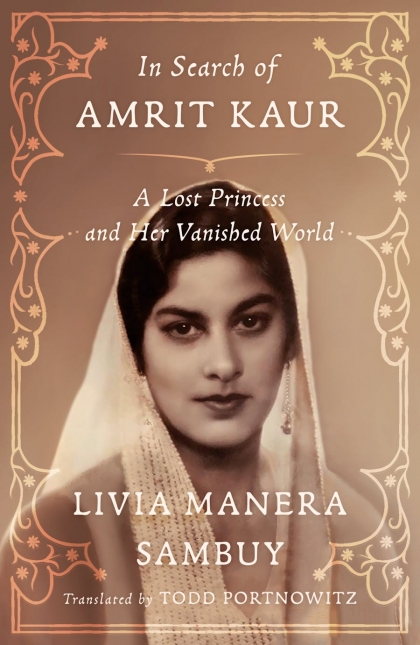In Search of Amrit Kaur: A Lost Princess and Her Vanished World
- By Livia Manera Sambuy; translated by Todd Portnowitz
- Farrar, Straus and Giroux
- 352 pp.
- Reviewed by Larry Matthews
- March 23, 2023
A detailed look at a not particularly compelling figure.

In Search of Amrit Kaur is a slow read by pretty much any standard. Think afternoon baseball or a cross-country bus trip, say Miami to Seattle. It’s one of those books where the author is seeking something and brings us along for the journey. The long, meandering journey.
You get the idea.
In 2007, Italian writer Livia Manera Sambuy was on assignment in India when she chanced upon a portrait of Amrit Kaur in a museum. She was “a slender young woman, whose grace, in that setting, shone like a ray of light. Tall, dark-skinned, her hair tied up, she wore an impalpable, translucent sari, its edges embroidered with gold or silver thread.”
Sambuy was immediately entranced and wanted to know more about the figure in the photo. But no information was available, and so she set out herself to find the details surrounding the lovely young woman whose portrait she was so taken with. Thus, a book was born.
Kaur was the sole daughter of a maharaja, a high-ranking member of Indian society, a kind of regional king. She was brought up in privilege unimaginable to most people, especially the lower classes in India. She was born during the period known as the Raj, British rule in India, in the early part of the 20th century.
Sambuy drags us along as she searches endlessly for the particulars of Kaur’s life. The sluggish narrative pace is frustrating, but she manages to offer a fascinating account of life in the India that existed under the Crown. The maharajas and plain old rajas, for example, kept their opulent lifestyles, their jewels, and their money but were relieved of the burden of actually ruling. The Brits were taking care of that.
Eventually, Kaur left her family, including her children, and headed for Europe in an apparent revolt against her husband’s taking of a second wife. She enjoyed the high life of Paris until, when France fell to the Germans in WWII, her link to Britain (via the Raj) caused the Nazis to suspect she was spying for London. Improbably, she was imprisoned in a concentration camp, where she waited out the war.
In the course of her traveling and rebelling, the author tells us, Kaur spent a few years in the United States in the company of a woman in San Diego; there’s a suggestion it was perhaps more than a simple friendship. She was also active in women’s rights during a time when such sentiments, especially in India, were not popular. Kaur was quoted as saying, “Let us discard the customs and traditions which have been strangling our domestic lives.” Hardly welcome words among the male ruling class.
Sambuy travels to India to interview Kaur’s daughter, now elderly and going by the name of Bubbles. The author tells Bubbles about her mother’s time with the Germans:
“It was difficult for me to guess what effects the news I’d brought from Europe was having on this eighty-year-old orphan. Squalor, prison, sickness, spies, Nazis, and a mother forced to beg for her life.”
Circumstances have clearly changed for the offspring of regional grandees in this post-Raj world. Bubbles, the granddaughter of a maharaja, has a son who’s a mechanic in Chicago. The family once owned “emeralds the size of walnuts, palaces inspired by Versailles.” Now? It’s all gone.
But what about poor Amrit Kaur herself, the woman who got us into this story? She had no love for the place her family once presided over. During her time there, it was still an era when widows burned themselves on the funeral pyres of their dead husbands. India offered little for a woman who wanted to experience the wider world, particularly life in Paris in the 1930s.
Sambuy writes, “I was astonished by just how many outlandish characters had found their way into Amrit’s orbit.” We meet many of them here; some would be considered flamboyant even by today’s jaded standards. Yet In Search of Amrit Kaur ends up being as much about the author as it is about her subject. We’re treated to the minutiae of Sambuy’s meetings with the people she interviews, down to what they ate and drank. There are also long passages about the years being investigated, which may be enough to hold the attention of readers keenly interested in a specific period in India.
Unfortunately, I am not one of them. As an author and former journalist trained to sniff out compelling stories, I asked myself what makes Kaur special enough to merit a book. Three hundred pages later, I still didn’t know the answer.
Larry Matthews is the author of Butterfly Knife.

